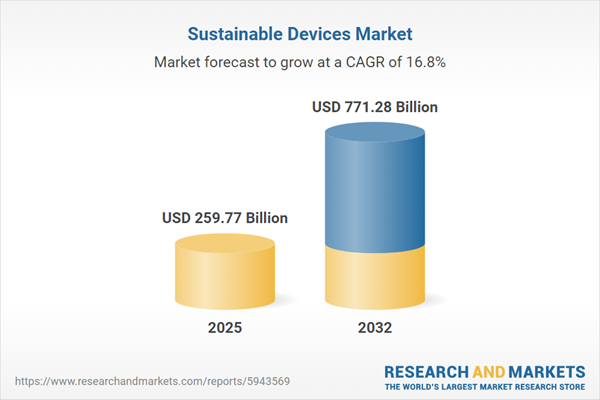Speak directly to the analyst to clarify any post sales queries you may have.
The sustainable devices market is rapidly transforming as organizations pursue eco-friendly design, efficient resource use, and technological integration at scale. Senior leaders are navigating an evolving landscape where sustainability drives both business value and market differentiation.
Market Snapshot: Sustainable Devices Market Size & Growth
The Sustainable Devices Market grew from USD 222.28 billion in 2024 to USD 259.77 billion in 2025. It is expected to continue growing at a CAGR of 16.82%, reaching USD 771.28 billion by 2032. Increased regulatory demands, shifting consumer expectations, and technological innovation are driving this market’s robust global expansion.
Sustainable Devices Market Scope & Segmentation
- Device Types: Laptops, smartphones, tablets, wearables
- Power Sources: Battery (lithium-ion, NiMH), hybrid, solar
- Applications: Commercial, home, industrial, transportation
- End Users: Consumers, enterprises, SMBs
- Distribution Channels: Online, retail
- Price Tiers: Entry level, mid range, premium
- Key Regions: Americas (North America—United States, Canada, Mexico; Latin America—Brazil, Argentina, Chile, Colombia, Peru), Europe, Middle East & Africa (United Kingdom, Germany, France, Russia, Italy, Spain, Netherlands, Sweden, Poland, Switzerland, UAE, Saudi Arabia, Qatar, Turkey, Israel, South Africa, Nigeria, Egypt, Kenya), Asia-Pacific (China, India, Japan, Australia, South Korea, Indonesia, Thailand, Malaysia, Singapore, Taiwan)
- Leading Companies: Tesla, Panasonic, First Solar, SunPower Corporation, Enphase Energy, SolarEdge Technologies, Schneider Electric, Siemens, BYD, ABB
Key Takeaways for Senior Decision-Makers
- Sustainability has evolved into a strategic differentiator across product development, procurement, and brand positioning.
- Innovation in materials, renewable integration, and modular architectures is enabling real-time environmental monitoring and device longevity.
- Supply chain transparency and ethical sourcing, supported by blockchain and certifications, are central to compliance and consumer trust.
- Shifting consumer values drive demand for circular economy models, while digital platforms facilitate activism and transparent reporting.
- Segment-specific needs influence design, materials, and energy solutions, reflecting diverse regulatory, commercial, and user contexts.
- Collaboration among startups, corporates, and suppliers accelerates product differentiation and fosters open innovation.
Sustainable Devices Market Tariff Impact: Navigating Policy Shifts
Recent tariff measures introduced by the United States in 2025 have increased costs for key components such as battery chemistries and semiconductors. This shift has prompted organizations to optimize design, diversify suppliers, and explore regional partnerships, reducing tariff exposure and driving supply chain efficiency. Closer collaboration among manufacturers and suppliers, along with adoption of government incentives, supports resilience and competitive adaptation across the industry.
Methodology & Data Sources
This analysis uses a multi-method approach combining in-depth primary interviews with executives, supply chain managers, and sustainability specialists, along with comprehensive secondary research from regulatory filings, technical papers, and industry reports. Quantitative market sizing integrates top-down and bottom-up techniques, validated through continuous peer review and triangulation for unbiased, robust market intelligence.
Why This Report Matters for Senior Leaders
- Identify actionable strategies to accelerate sustainable device innovation and optimize value chains.
- Gain clarity on evolving regulations, consumer expectations, and technology adoption to inform targeted investments.
- Benchmark against leading organizations leveraging circularity, transparent reporting, and policy incentives to achieve commercial and environmental objectives.
Conclusion
The sustainable devices market is set for continued transformation as innovation and policy changes redefine value. Organizations embracing circular design, stakeholder engagement, and adaptive sourcing are positioned for lasting competitive advantage. This report equips leaders to make informed decisions and realize growth in a market shaped by sustainability and technology.
Additional Product Information:
- Purchase of this report includes 1 year online access with quarterly updates.
- This report can be updated on request. Please contact our Customer Experience team using the Ask a Question widget on our website.
Table of Contents
3. Executive Summary
4. Market Overview
7. Cumulative Impact of Artificial Intelligence 2025
Companies Mentioned
The companies profiled in this Sustainable Devices market report include:- Tesla, Inc.
- Panasonic Corporation
- First Solar, Inc.
- SunPower Corporation
- Enphase Energy, Inc.
- SolarEdge Technologies, Inc.
- Schneider Electric SE
- Siemens AG
- BYD Company Limited
- ABB Ltd.
Table Information
| Report Attribute | Details |
|---|---|
| No. of Pages | 193 |
| Published | October 2025 |
| Forecast Period | 2025 - 2032 |
| Estimated Market Value ( USD | $ 259.77 Billion |
| Forecasted Market Value ( USD | $ 771.28 Billion |
| Compound Annual Growth Rate | 16.8% |
| Regions Covered | Global |
| No. of Companies Mentioned | 11 |









